
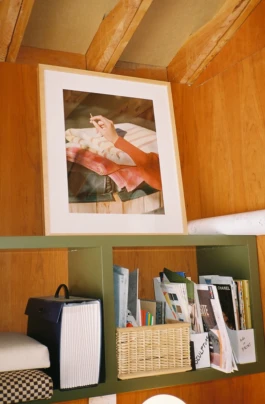
Miss Modular
Adi Goodrich is a sentimental punk at heart who is hell-bent on creating something out of nothing in a field where set design can easily be misguided. Rather than bathing a room and its objects in brand colors and calling it a day, Goodrich starts with a blank slate and buckets full of curiosity, the way her craftsman father taught her growing up on a rural farm on the outskirts of Chicago.
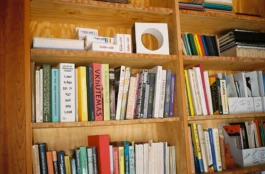
Now firmly planted in Los Angeles, she runs Sing-Sing Studio with her partner, filmmaker Sean Pecknold. She’s also recently launched a furniture collection, “Frunchroom,” inspired by her South Side roots hanging out in the family room and entertaining one another while her Grandma sipped RC cola. If you listen closely, it sounds like “front room” smashed together with a twisted pronunciation.
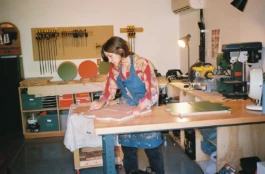
Smashing together things has been Goodrich’s preferred design method. It’s why contrast is at the heart of her design work, which is informed by deeply researched historic architectural styles. informed by surrealism, she produces a confrontation of aesthetic worlds we’ve never laid eyes on. Goodrich’s calling is simple: to design with an unspoiled perspective.
First things first, how did you fall into the rabbit hole of design?
I definitely fell into it by chance - my Dad was a woodworker - he worked in restoration. We also had an antique store and he was always a tinkerer and a woodworker. At a very, very young age I became his sidekick, ripping apart houses alongside him and working in restoration of homes, local businesses in our small town and furniture restoration. On Saturdays we’d geek out watching Bob Vila - so the curiosity of design was always something I lived with.
I loved the idea that someone like my dad, who was untrained, could build or restore objects and architecture, even with the limited resources we had in rural Illinois. I began to find truth in that if you have ambition and curiosity you can make anything happen.
So that's kind of always been my ethos: start with what piques your curiosity and then go from there. And for me it was going to art school. I studied painting and drawing and then took as many architectural preservation classes as I could. I found myself drawn to the combination of art and architecture. And I think that’s what design is: a combination of art and utility; design is intended for people to live with, which I think is what interests me the most. I love the human element of what art can become when you live within it.
And then after graduating from art school I magically got a job doing window displays.
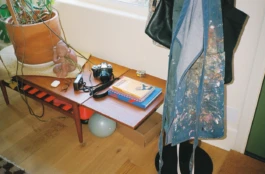
Did design bring you to LA?
What brought me to LA was designing window displays for Barney’s and Anthropologie and then building sets with my friends in a film collective we founded called The Sirocco Research Labs.. That quickly led to work in the commercial world as a Set Designer which I’ve been doing now for fifteen years. In 2015, my partner Sean Pecknold and I started our own studio called Sing-Sing.
Through all the projects we’ve done as a studio- I've always seen myself as the designer and Sean is more story-driven; My interests are in color and materials. His, in lighting and the arc of a story. We’ve done a variety of projects and think of ourselves as medium agnostic - set design for live events, photography, filmmaking, animation, interior design and live visuals for music performances. We love working on a variety of scales- sometimes it’s a music performance for 20,000 people or it’s on a really small scale working in animation with miniatures. We're a very multidisciplinary studio. And we split the roles pretty clearly - Adi Goodrich designer, Sean Pecknold filmmaker.
More and more, design is becoming a multidisciplinary sport. Sing-Sing is no exception. How have you found the studio to be an anything-goes design source for clients?
I think it comes back to both Sean and I being interested in world building, as cheesy as it might sound. We try to not limit our work to a certain medium but think instead of problem solving through design and storytelling.
“My interests are in color and materials. His, in lighting and the arc of a story.”
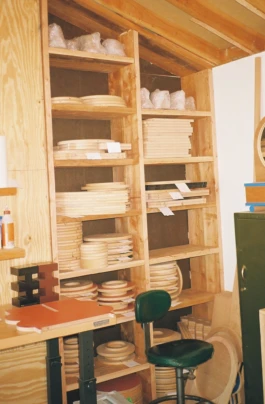
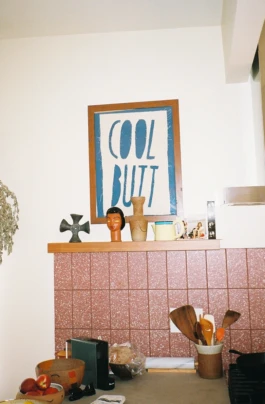
You’ve worked on a range of commercial and office spaces, each unique in their identity. What does your design research process look like?
I'm constantly inspired by art and design history. I think researching these areas is so interesting because it reveals the story of how design can be shaped by current technology, politics and the environment around you. In my world-building projects (interiors and set design) I generally create a story to wrap the design around. For me, it’s a way to be really intentional with materials and colors. If there’s a narrative, there’s generally less ambiguity in design decisions.
For example, Wine and Eggs was inspired by the time I spent in Paris and New York. I referenced the bodegas of NYC and the tabacs in Paris. I wanted to create a space that felt timeless and elegant but humble. It was intended to add a bit of joy to people’s lives but still be welcoming to anyone in the neighborhood. So, the materials echoed that sentiment.
With my project Dreams, inspiration came from the Surrealism movement. And why we chose that was that the store’s opening was in the middle of the pandemic. And how surreal is that situation if you really break it down: opening up a store when no one's shopping in the real world. So we aimed to create a store that people would really want to visit, perhaps even pilgrimage to. Once inside, I used the idea of curiosity to pique the minds of our visitors and offer a place that would guide them around surreal moments of design. I.E. a large blue rock under an illuminated sky ceiling.
“If there’s a narrative, there’s generally less ambiguity in design decisions.”
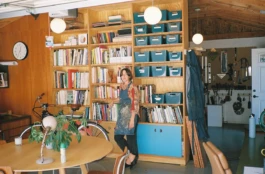
Behind every great designer is a furniture capsule. Tell us about Sing-Thing and how you developed your first collection, “The Frunchroom.” Out of curiosity, Is that name a portmanteau?
Frunchroom is what you call the family room in Chicago. It's a Southside word. It's supposed to be “front room,” but we say "Frunchroom.” I decided to call it that because the Frunchroom is where people gather and hang out with their loved ones. It’s a humble space. So the collection was about the people and moments that inspired me in my life. I have the Dorothy Daisy table, which is inspired by my Grandma, the Lina table, which is inspired by Lina Marrari, who basically raised me and my brother and my sister. Each object refers to a family member or someone that inspired me throughout a pretty hectic upbringing - and it’s a happy accident that most of these people are strong females.
In short, the collection was made because I had the desire to get back into woodworking, which I grew up doing and hadn't done for many years. The material choices and the way that the pieces are built, which is mostly assembly of pre-cut parts, was made out of necessity and the restriction of having a really small woodshop.
I think contrast is a word I use often as well. Thinking about the materials of the furniture line contrast is definitely there. The two materials I’m using are cherry wood and high pressure laminate, which are complete opposites when you think of how they are created and the care it takes for upkeep. Laminate is manufactured, super-saturated in color, and can be wiped clean with a Clorox disinfecting wipe. It’s a mid-century material that boasts ease of car. It doesn’t get more modest. Whereas Cherry wood needs to be oiled and cared for, it’s a natural material and has an almost early-american/ Fine Woodworking Magazine vibe.
I use the element of contrast in all of my interior work too, where I'm mixing high end materials with super low end materials. To me, it really has a nice balance when done right.
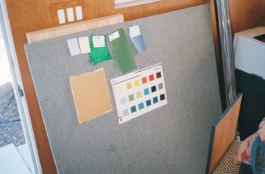
Your work spins pretty ordinary materials into extraordinarily unfamiliar sights. Is that decision key in your approach?
Ubiquitous, everyday materials, how they're used and the layers of these materials are really inspiring to me. Me and my partner take these really long city walks to get inspired. We’ll choose a street - Wilshire Blvd and walk the length of it (18 miles from Downtown to Santa Monica) For example, on a walk I'll see a green drape in a store window - an orange painted brick facade in front of it, and an aged plexi light box sign above - All of which had no ‘designer’ making these decisions. The layers of these materials and the choices made from numerous residents is a natural collaging that I’m inspired by. I take these random pairings into my designs when working and it feels really strange and wonderful.

“I start my days by reading either artist biographies or interviews. That sets the tone for the day.”
Where do you collect inspiration? Any books, places, music, or exhibitions you’ve found yourself drawn to lately?
I start my days by reading either artist biographies or interviews. That sets the tone for the day. But, most inspiration comes from walking and experiencing environments. I try to find inspiration off the internet so I don’t get tricked into doing things others have already done. A lot of my inspiration comes from when we are traveling or doing these city walks. We also try to keep a pretty robust reference library that I’ll dig into when I’m stuck on a project.
As far as what has inspired me lately: I did see an exhibition called Soup & Tart at Moca that was one night only. It was a recreation of an event devised by Fluxus artist Jean Dupuy in 1974 and held at The Kitchen in downtown New York. The event at MoCa was fifty artists, musicians, and dancers from across Los Angeles’ cultural landscape who performed for two minutes. There was no exhibition, just a bunch of pillows on the floor and three microphones. Viewers were surrounded by artists doing very informal performances.
It felt very freeing and it didn’t take itself too seriously. It felt like the freedom I had in art school.
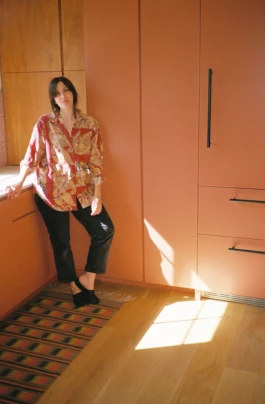
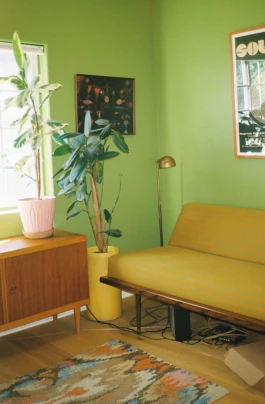
What do you find unique about practicing design in LA?
My LA is different from anyone else's Los Angeles. My Los Angeles is rooted in filmmaking production, so I've relied on the relationships I’ve made in that industry and the resources that filmmakers and set designers use. I think that’s pretty specific to this city and what makes our scene really special.
I feel like in Los Angeles designers are open to exploration and experimentation. They get weird and often are not playing by the rule book. I feel a freedom here that I can do what I want and there will be an audience that’s interested. I've always felt that. Coming from Chicago, it’s always felt like the wild, wild West. I’ve maintained the idea that if you show up, work hard and make the work, you’ll be fine.
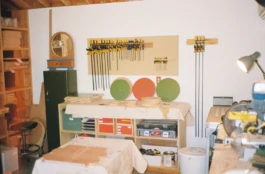

Miss Modular

Adi Goodrich is a sentimental punk at heart who is hell-bent on creating something out of nothing in a field where set design can easily be misguided. Rather than bathing a room and its objects in brand colors and calling it a day, Goodrich starts with a blank slate and buckets full of curiosity, the way her craftsman father taught her growing up on a rural farm on the outskirts of Chicago.

Now firmly planted in Los Angeles, she runs Sing-Sing Studio with her partner, filmmaker Sean Pecknold. She’s also recently launched a furniture collection, “Frunchroom,” inspired by her South Side roots hanging out in the family room and entertaining one another while her Grandma sipped RC cola. If you listen closely, it sounds like “front room” smashed together with a twisted pronunciation.

Smashing together things has been Goodrich’s preferred design method. It’s why contrast is at the heart of her design work, which is informed by deeply researched historic architectural styles. informed by surrealism, she produces a confrontation of aesthetic worlds we’ve never laid eyes on. Goodrich’s calling is simple: to design with an unspoiled perspective.
First things first, how did you fall into the rabbit hole of design?
I definitely fell into it by chance - my Dad was a woodworker - he worked in restoration. We also had an antique store and he was always a tinkerer and a woodworker. At a very, very young age I became his sidekick, ripping apart houses alongside him and working in restoration of homes, local businesses in our small town and furniture restoration. On Saturdays we’d geek out watching Bob Vila - so the curiosity of design was always something I lived with.
I loved the idea that someone like my dad, who was untrained, could build or restore objects and architecture, even with the limited resources we had in rural Illinois. I began to find truth in that if you have ambition and curiosity you can make anything happen.
So that's kind of always been my ethos: start with what piques your curiosity and then go from there. And for me it was going to art school. I studied painting and drawing and then took as many architectural preservation classes as I could. I found myself drawn to the combination of art and architecture. And I think that’s what design is: a combination of art and utility; design is intended for people to live with, which I think is what interests me the most. I love the human element of what art can become when you live within it.
And then after graduating from art school I magically got a job doing window displays.

Did design bring you to LA?
What brought me to LA was designing window displays for Barney’s and Anthropologie and then building sets with my friends in a film collective we founded called The Sirocco Research Labs.. That quickly led to work in the commercial world as a Set Designer which I’ve been doing now for fifteen years. In 2015, my partner Sean Pecknold and I started our own studio called Sing-Sing.
Through all the projects we’ve done as a studio- I've always seen myself as the designer and Sean is more story-driven; My interests are in color and materials. His, in lighting and the arc of a story. We’ve done a variety of projects and think of ourselves as medium agnostic - set design for live events, photography, filmmaking, animation, interior design and live visuals for music performances. We love working on a variety of scales- sometimes it’s a music performance for 20,000 people or it’s on a really small scale working in animation with miniatures. We're a very multidisciplinary studio. And we split the roles pretty clearly - Adi Goodrich designer, Sean Pecknold filmmaker.
More and more, design is becoming a multidisciplinary sport. Sing-Sing is no exception. How have you found the studio to be an anything-goes design source for clients?
I think it comes back to both Sean and I being interested in world building, as cheesy as it might sound. We try to not limit our work to a certain medium but think instead of problem solving through design and storytelling.
“My interests are in color and materials. His, in lighting and the arc of a story.”


You’ve worked on a range of commercial and office spaces, each unique in their identity. What does your design research process look like?
I'm constantly inspired by art and design history. I think researching these areas is so interesting because it reveals the story of how design can be shaped by current technology, politics and the environment around you. In my world-building projects (interiors and set design) I generally create a story to wrap the design around. For me, it’s a way to be really intentional with materials and colors. If there’s a narrative, there’s generally less ambiguity in design decisions.
For example, Wine and Eggs was inspired by the time I spent in Paris and New York. I referenced the bodegas of NYC and the tabacs in Paris. I wanted to create a space that felt timeless and elegant but humble. It was intended to add a bit of joy to people’s lives but still be welcoming to anyone in the neighborhood. So, the materials echoed that sentiment.
With my project Dreams, inspiration came from the Surrealism movement. And why we chose that was that the store’s opening was in the middle of the pandemic. And how surreal is that situation if you really break it down: opening up a store when no one's shopping in the real world. So we aimed to create a store that people would really want to visit, perhaps even pilgrimage to. Once inside, I used the idea of curiosity to pique the minds of our visitors and offer a place that would guide them around surreal moments of design. I.E. a large blue rock under an illuminated sky ceiling.
“If there’s a narrative, there’s generally less ambiguity in design decisions.”

Behind every great designer is a furniture capsule. Tell us about Sing-Thing and how you developed your first collection, “The Frunchroom.” Out of curiosity, Is that name a portmanteau?
Frunchroom is what you call the family room in Chicago. It's a Southside word. It's supposed to be “front room,” but we say "Frunchroom.” I decided to call it that because the Frunchroom is where people gather and hang out with their loved ones. It’s a humble space. So the collection was about the people and moments that inspired me in my life. I have the Dorothy Daisy table, which is inspired by my Grandma, the Lina table, which is inspired by Lina Marrari, who basically raised me and my brother and my sister. Each object refers to a family member or someone that inspired me throughout a pretty hectic upbringing - and it’s a happy accident that most of these people are strong females.
In short, the collection was made because I had the desire to get back into woodworking, which I grew up doing and hadn't done for many years. The material choices and the way that the pieces are built, which is mostly assembly of pre-cut parts, was made out of necessity and the restriction of having a really small woodshop.
I think contrast is a word I use often as well. Thinking about the materials of the furniture line contrast is definitely there. The two materials I’m using are cherry wood and high pressure laminate, which are complete opposites when you think of how they are created and the care it takes for upkeep. Laminate is manufactured, super-saturated in color, and can be wiped clean with a Clorox disinfecting wipe. It’s a mid-century material that boasts ease of car. It doesn’t get more modest. Whereas Cherry wood needs to be oiled and cared for, it’s a natural material and has an almost early-american/ Fine Woodworking Magazine vibe.
I use the element of contrast in all of my interior work too, where I'm mixing high end materials with super low end materials. To me, it really has a nice balance when done right.

Your work spins pretty ordinary materials into extraordinarily unfamiliar sights. Is that decision key in your approach?
Ubiquitous, everyday materials, how they're used and the layers of these materials are really inspiring to me. Me and my partner take these really long city walks to get inspired. We’ll choose a street - Wilshire Blvd and walk the length of it (18 miles from Downtown to Santa Monica) For example, on a walk I'll see a green drape in a store window - an orange painted brick facade in front of it, and an aged plexi light box sign above - All of which had no ‘designer’ making these decisions. The layers of these materials and the choices made from numerous residents is a natural collaging that I’m inspired by. I take these random pairings into my designs when working and it feels really strange and wonderful.

“I start my days by reading either artist biographies or interviews. That sets the tone for the day.”
Where do you collect inspiration? Any books, places, music, or exhibitions you’ve found yourself drawn to lately?
I start my days by reading either artist biographies or interviews. That sets the tone for the day. But, most inspiration comes from walking and experiencing environments. I try to find inspiration off the internet so I don’t get tricked into doing things others have already done. A lot of my inspiration comes from when we are traveling or doing these city walks. We also try to keep a pretty robust reference library that I’ll dig into when I’m stuck on a project.
As far as what has inspired me lately: I did see an exhibition called Soup & Tart at Moca that was one night only. It was a recreation of an event devised by Fluxus artist Jean Dupuy in 1974 and held at The Kitchen in downtown New York. The event at MoCa was fifty artists, musicians, and dancers from across Los Angeles’ cultural landscape who performed for two minutes. There was no exhibition, just a bunch of pillows on the floor and three microphones. Viewers were surrounded by artists doing very informal performances.
It felt very freeing and it didn’t take itself too seriously. It felt like the freedom I had in art school.


What do you find unique about practicing design in LA?
My LA is different from anyone else's Los Angeles. My Los Angeles is rooted in filmmaking production, so I've relied on the relationships I’ve made in that industry and the resources that filmmakers and set designers use. I think that’s pretty specific to this city and what makes our scene really special.
I feel like in Los Angeles designers are open to exploration and experimentation. They get weird and often are not playing by the rule book. I feel a freedom here that I can do what I want and there will be an audience that’s interested. I've always felt that. Coming from Chicago, it’s always felt like the wild, wild West. I’ve maintained the idea that if you show up, work hard and make the work, you’ll be fine.
